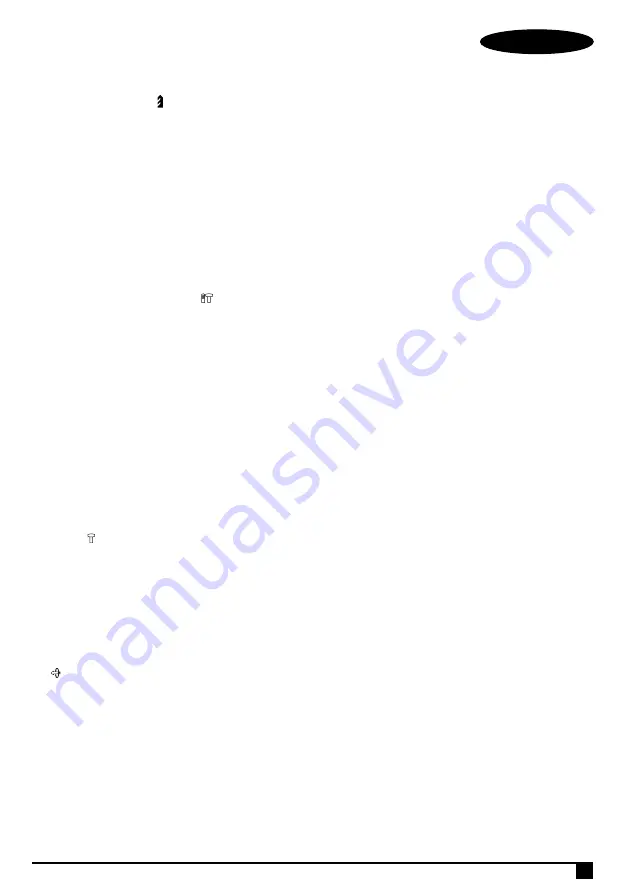
7
ENGLISH
Drilling (Fig. B & F)
u
For drilling in steel, wood and plastics set the operating
mode selector (3) to the position.
u
It is necessary to use a suitable drill chuck (13) (optional
accessory) to clamp the attachment rod.
u
Insert the drill chuck (13) into the tool chuck (4) according
to the instructions for installing attachments.
u
Turn the drill chuck (4) to loosen the clamps at the
front end of the drill clamp and insert the accessory bar
(14) into the clamps and turn the chuck in the opposite
direction.
u
You can also use the drill chuck key to tighten the clamp.
Hammer drilling (Fig. B)
u
For hammer drilling in masonry and concrete, set the
operating mode selector (3) to the
position.
u
The drill bit has to be placed accurately onto the drill hole
position.
u
The drill bit has to be placed accurately onto the drill hole
position. After that, pull the switch for optimal effects.
u
Make sure the tool is in the correct position to prevent the
drill from deviating from the hole.
u
When the drill hole is clogged with debris or fine powder,
do not exert any more pressure.
u
Put the tool in free-running state before removing part of
the drill bit from the hole.
u
Repeat a few times and the blockage in the hole will be
cleared, and normal drilling can resume.
Impact drilling (fig. B)
u
When chisel/peel/dismantle, turn the mode selector (3) to
position for tip bid, cold chisel, scaling chisel.
Note:
Do not change the mode selector (3) when the tool is
running.
u
Repeat adjustment can change the position if the chisel
angle.
Deflection angle (chisel/peel/dismantle) (Fig.G)
u
The drill head can be moved to different angles.
u
Change the angle by turning the mode selector (3) to the
position.
u
Turn the drill head to the required angle.
Warning!
If the drill bit hits cement or steel rebar in cement,
the tool may recoil dangerously. Please hold the tool tightly in
a balanced and stable position at all times to prevent it from
recoiling dangerously.
Overload coupling device
If the drill bit is caught or hooked, the driving force transmitted
to the drill shaft will be cut out. This wil generate a strong
recoil, so it is necessary to hold the tool tightly with both hands
and remain in a stable position.
Setting the drilling depth (Fig. E)
The depth stop is a convenient feature to ensure uniformity
in drilling depth. Loosen the side handle to adjust the depth
gauge according to the required depth. After that, tighten the
side handle.
u
Slacken the side handle (5) by turning the grip
counterclockwise.
u
Set the depth stop (6) to the required position. The
maximum drilling depth is equal to the distance between
the tip of the drill bit and the front end of the depth stop.
u
Tighten the side handle by turning the grip clockwise.
Switching on and off
Warning!
Before plugging in to the power source, make sure
the switch can be flipped freely, and can return to its original
position once released.
u
To switch the tool on, press the variable speed switch (1).
The tool speed depends on how far you press the switch.
u
As a general rule, use low speeds for large diameter drill
bits and high speeds for smaller diameter drill bits.
u
For continuous operation, press the lock-on button (2) and
release the variable speed switch.
u
To switch the tool off, release the variable speed switch.
To switch the tool o when in continuous operation, press
the variable speed switch once more and release it.
Accessories
The performance of your tool depends on the accessory used.
BLACK+DECKER and Piranha accessories are engineered
to high quality standards and designed to enhance the
performance of your tool. By using these accessories you will
get the very best from your tool.
Maintenance
Your BLACK+DECKER tool has been designed to operate
over a long period of time with a minimum of maintenance.
Continuous satisfactory operation depends upon proper tool
care and regular cleaning.
Your charger does not require any maintenance apart from
regular cleaning.
Warning!
Before performing any maintenance on the tool,
remove the battery from the tool. Unplug the charger before
cleaning it.
u
Regularly clean the ventilation slots in your tool and
charger using a soft brush or dry cloth.
u
Regularly clean the motor housing using a damp cloth.
Do not use any abrasive or solvent-based cleaner.
u
Regularly open the chuck and tap it to remove any dust
from the interior.

























